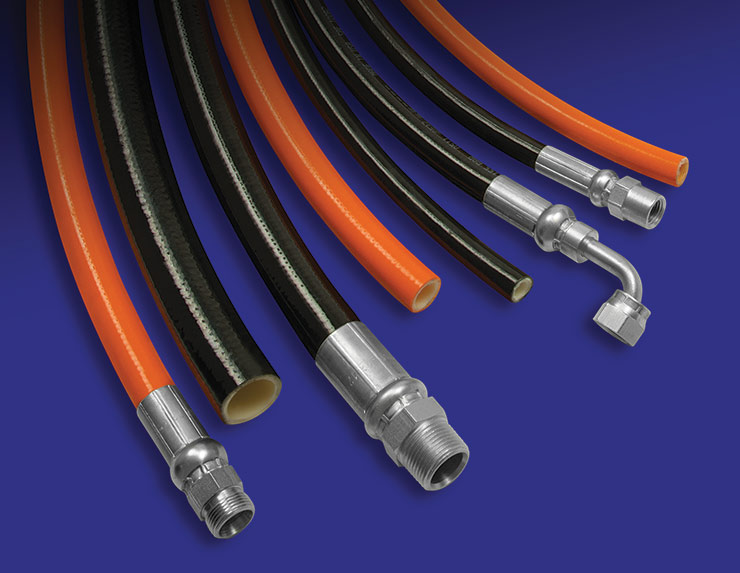Thermoplastics are polymers with a unique capacity to become soft, pliable and moldable when heated while solidifying upon cooling. The moldability range lies between its glass transition temperature* and its melting point, so it’s essential to avoid overheating the material. Popular techniques such as injection molding and extrusion produce many of the devices and parts you use every day, but thermoplastics have their uses in fluid power as well.

The construction of thermoplastic hydraulic hose is not unlike their synthetic rubber counterparts. You still use an inner tube and outer cover separated by one or more reinforcement layers but with different functional qualities. Although thermoplastic polymers come in dozens of formulations, you’ll recognize the most common plastics such as polyester, nylon and polytetrafluoroethylene (PTFE), commonly used as the inner tube material.
The reinforcement layer is available with similar materials and construction as standard hydraulic hose, except multi-layer spiral wound reinforcement is rarer. The reinforcement may be polyester, aramid or steel wire, and in some cases, may replace the outer cover altogether. However, it’s more common to see a cover also made from thermoplastic because the primary reasons for choosing the material remain consistent. A benefit to thermoplastic hose is how the tube, reinforcement and cover can be heated and formed in the final step to produce a near homogenous final product.
Thermoplastic hose has many intrinsic benefits, which may or may not be your reason for selecting them. The natural strength of thermoplastic permits thinner inner tubes and outer covers, providing an overall compact hydraulic hose. As well, inner tubes such as nylon and polyester provide the hose with excellent flexibility, enjoying as much as half the bend radius of a comparable 100R2 hose, for example.
Applications requiring non-conductive hydraulic hoses, such as mobile equipment for electrical utilities, benefit from thermoplastics’ electrically insulating effect, especially so when the reinforcement is also thermoplastic, such as with nylon or polyester. Often sold under the 100R7 and 100R8 definition, non-conductive hose is a top choice for any fluid conveyance where the potential to transmit or spark electricity exists; blowout preventers, hydraulic lifts and construction machinery, to name a few.
As if the resume of thermoplastic hose wasn’t already impressive enough, it brings to the table exceptional chemical resistance as well. If your application uses synthetic hydraulic fluid such as phosphate ester, the thermoplastic tube protects you from failure where more common synthetic rubber cannot cope. Even water glycol is no match for thermoplastic, although the presence of water does lower the maximum temperature rating of the hose.
Thermoplastic hose is not perfect, however. The thermoplastic nature prevents high-temperature operation, so don’t expect more than 200°F in the best-case scenario. Moreover, thermoplastic is not the top choice for ultra-high pressure, where spiralled steel is king. Regardless, thermoplastic hydraulic hose is an excellent overall choice for most applications; chemical resistance, flexibility, non-conductivity and compact size make it suited for even the most demanding applications.
* Glass-Transition is gradual and reversible transition from the soft, pliable plastic compound to its harder, more brittle state. Technically speaking, thermoplastics are glass.
Filed Under: Hose & Tubing, Hose Assembly Tips